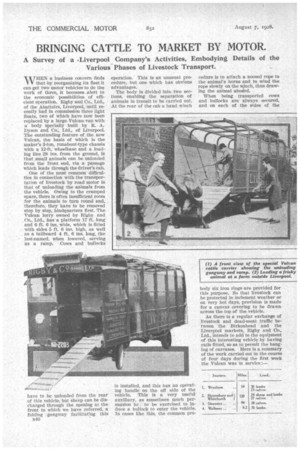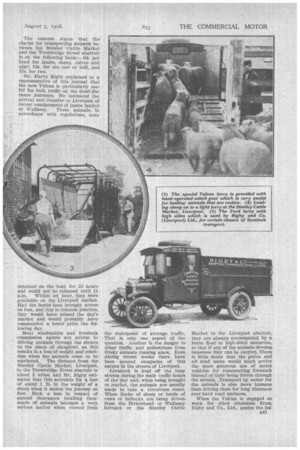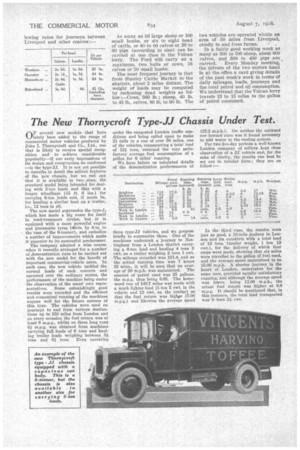BRINGING CATTLE TO MARKET BY MOTOR.
Page 58

Page 59

Page 60

If you've noticed an error in this article please click here to report it so we can fix it.
AA THEN a business concern finds V that by reorganizing its fleet it can get two motor vehicles to do the work of three, it becomes alert to the economic possibilities of efficient operation. Rigby and Co., Ltd., of the Abattoirs, Liverpool, until recently had in commission three light floats, two of which have now been replaced by a large Vulcan van with a body specially built by R. A. Dyson and Co., Ltd., of Liverpool. The outstanding feature of the new Vulcan, the basis of which is the maker's 3-ton, runabout-type chassis with a 12 ft. wheelbase and a loading line 28 ins, from the ground, is that sniall animals can be unloaded from the 'front end, via a passage which leads through the driver's cab.
One of the most common difficulties in connection with the transportation of livestock by road motor is that of unloading the animals from the vehicle. Owing to the cramped space, there is often insufficient room for the animals to turn round and, therefore, they have to be removed step by step, hindquarters first. The Vulcan lorry owned by Rigby and Co., Ltd., has a platform 17 ft. long and 6 ft 6 ins. wide, which is fitted with sides 5 ft. 6 ins, high, as well as a tailboard 4 ft. 6 ins, long, the last-named, when lowered, serving as a ramp. Cows and bullocks
have to be unloaded from the rear' of this vehicle, but sheep can be discharged through the opening at the front to which we have referred, a folding gangway facilitating this B40 operation. This is an unusual procedure, but one which has obvious advantages.
The body is divided into two sections, enabling the separation of animals in transit to be carried out. At the rear of the cab a hand winch is installed, and this has an operating handle on the off side of the vehicle. This iS a very useful auxiliary, as sometimes much persuasion hr_; to be exercised to induce a bullock te enter the vehicle. In cases like this, the common pro cedure is to attach a noosed rope to the animal's horns and to wind the rope slowly on the winch, thus drawing the animal aboird.
When being transported cows and bullocks are always secured, and on each of the sides of the body six iron rings are provided for this purpose. So that livestock can be protected in inclement weather or on very hot days, provision is made for a canvas covering to be drawn across the top of the vehicle.
As there is a regular exchange of livestock and dead-meat traffic between the Birkenhead and the Liverpool markets, Rigby and Co., Ltd., intends to add to the equipment of this interesting vehicle by having rails fitted, so as to permit the hanging of carcases. Here is a summary of the work carried out in the course of four days during the first week the Vulcan was in service:— The concern states that the charge for transporting animals between the Stanley Cattle Market and the Trowbridge Street abattoir
is on the following basis per head for lambs, sheep, calves ,and pigs ; 10s. for one cow or bull, and 15s. for two.
Mr. Harry Rigby explained to a representative of this journal that the new Vulcan is particularly useful for bulk traffic on the short-distance journeys. He instanced the arrival and transfer to Liverpool of recent consignments of lambs landed
at Wallasey. These animals, in accordance with regulations, were
detained on the boat for 10 hours and could not be released until 11 a.m. Within an hour, they were available on the Liverpool market. Had the lambs been brought across on foot, and this is common practice, they would have missed the day's market and would probably have commanded a lower price the following day.
Meat wholesalers and livestock commission agents are averse to driving animals through the streets to the place of slaughter, as this results in a loss of weight and condition when the animals come to be marketed. The distance from the Stanley Cattle Market, Liverpool, to the Trowbridge Street abattoir is about 2 miles, and Mr. Rigby estimates that this accounts for a loss of about 1 lb. in the weight of a sheep when it makes the journey on foot. Such a loss in respect of annual clearances totalling thousands of animals becomes a very serious matter when viewed from
the standpoint of average traffic. That is only one aspect of the question. Another is the danger to other traffic and pedestrians from frisky animals running amok. Even during recent weeks there have been several escapades of this nature in the streets of Liverpool.
Livestock is kept off the busy streets during the main traffic hours of the day and, when being brought to market, the animals are usually made to take a circuitous route. When flocks of sheep or herds of cows or bullocks are being driven from the Birkenhead or Wallasey lairages or the Stanley Cattle Market to the Liverpool abattoir, they are always accompanied by a horse float or high-sided motorvan, so that if any of the animals develop lameness they can be carried. There Is little -doubt that the police and all road users would much prefer the more generous use of motor vehicles for transporting livestock instead of their being driven through the streets. Transport by motor for the animals is also more humane than driving them for long distances over hard road surfaces.
When the Vulcan is engaged on work for other wholesale firms, Rigby and Co., Ltd., quotes the totB41.
lowing rates for journeys between Liverpool and other centres:
As many as 50 large sheep or 100 small lambs, or six to eight head of cattle, or 40, to 60 calves or 30 to 60 pigs (according to size) can be carried at one time in the Vulcan lerry. The Ford will carry as a maximum, two bulls or cows, 16 calves or 20 small lambs.
The most frequent journey is that from Stanley Cattle Market to the abattoir, about 2 miles distant. The weight of loads may be computed by reckoning dead weights as follow :-Cows, 560 lb.; sheep, 40 lb. to 45 lb., calves, 80 lb. to 90 lb. The two vehicles are operated within an area of 50 miles from Liverpool, chiefly to and from farms.
In a fairly good working week as many as 300 to 500 sheep, about 600 calves, and 300 to 400 pigs are carried. Every Monday morning, the drivers of the two motors hand in at the office a card giving details of the past week's work in terms of daily mileages, loads, journeys and the total petrol and oil consumption. We understand that the Vulcan lorry travels 13 to 15 miles to the gallon of petrol consumed.




































































































